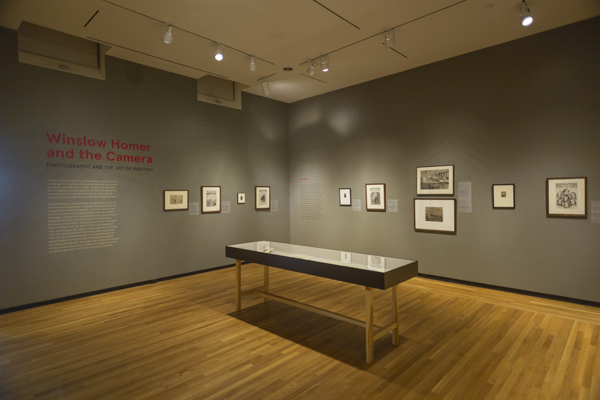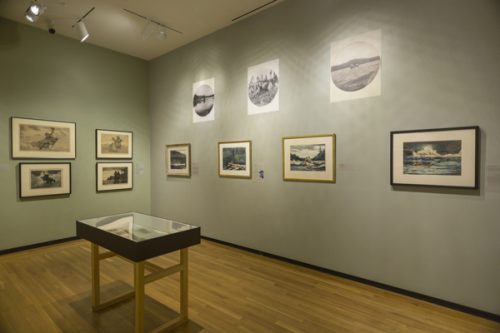Behind-the-Scenes of Winslow Homer and the Camera: Photography and the Art of Painting
By Bowdoin Museum of ArtCurious about the ideas that go into an exhibition like Winslow Homer and the Camera? In this interview conducted by Ellie Sapat ’20, Frank Goodyear, the co-director of the Museum and co-curator of the Homer exhibition, discusses what inspired the show, the challenges he faced, his favorite pieces, and what’s next for the exhibition.

What was the inspiration behind this exhibition?
In 2013, we got a phone call from Neal Paulson, who claimed to own a camera that belonged to Winslow Homer, and who was interested in showing the camera to the Museum. At first, we were a little surprised and confused—we didn’t know Homer had a connection to photography, especially because so many artists of the period either rejected the emerging technology or were ambivalent towards it. But we learned over several months of research that the camera was definitely Homer’s: his initials were carved into it, and the Museum owns photographs in its Homer archive that fit the size and type that would have been produced by this camera. However, in most of the research done on Homer, there is little that mentions his interest in photography. For the most part, no one had gone into depth on the subject of the camera’s influence on Winslow Homer. Getting this camera and realizing he didn’t take mere snapshots prompted us to ask: how does his connection to photography change the way we see Homer, his artistic practice, and his commitment to portraying the real thing? The show grew from there.
What was the most surprising thing you learned while researching for this exhibition?
What was really surprising was that in so much scholarly literature, no one really talked about this before! Homer was an artist committed to realistically representing the world as it is, who clearly studied what was in front of him. If a new visual technology like photography was being introduced, why wouldn’t you assume that he would consider or use it? As to why the art history community didn’t focus on this aspect of his career, it could be that they privileged him as a painter. . . which is not necessarily inappropriate—Homer thought of himself first and foremost as a painter. In this exhibition, we are not claiming he was a fine art photographer; we are claiming he was interested in it as a tool and as another way to consider sight and mediated vision in his art.
What was your favorite part of working on this show?
My favorite part of working on this show was how exciting it was to have a partner in Dana Byrd, the co-curator of the exhibition. It was wonderful to have someone to meet with, bounce ideas off of, and share research with. It was also great to work on such a talented artist. Yes, a familiar subject, but one who we came to see in a new light, as someone who set an important precedent for the emergence of modernism through his interest in montage, searliality, abstraction, and vision. We came to see him not exclusively as a painter of nostalgic landscapes, but as an artist deeply engaged with social and political issues of day.
What was an unexpected challenge for this exhibition?
A challenge that was difficult, but not unexpected, was securing loans —we are very appreciative of the 26 lenders to this show. It’s not easy to ask someone to lend valuable works of art that are fragile or already hanging in a gallery! So it was difficult to bring together all these pieces. A more unexpected challenge, once we had secured the loans, was figuring out how to organize work in the Museum’s downstairs galleries. It’s one thing to have an idea and select a group of pictures that support it, it’s another thing to put ideas on the wall and make it look elegant and engaging.

What is your favorite piece in the show?
Well, my favorite wall is in the Becker Gallery—it’s the wall with the four watercolors of water and canoes. It blows me away, especially knowing he took photos of bodies of water with canoes in them. His works meditating on the visual effects of water at different times and in different weather are great.
This is a pretty original and exciting exhibition—what do you hope visitors get from it? What do you want them to notice and think about?
Henry James once gave Homer a backhanded compliment, remarking on his “perfect realism,” implying that no matter how well Homer represented what was in front of him, he did not allow his own imagination to take precedent in portraying a specific scene. But I want visitors to take away the true hybrid nature of Homer’s artistic practice. While his objective was an accurate rendering of what he was painting, the route to achieve that was through a lot of preparatory studies, tools like the camera, and thinking. It was not the result of some brief encounter outdoors. Homer was a well studied, highly creative, and innovative artist who set the table for many important artistic questions in subsequent generations.
What is next for this show?
Right now it’s very exciting to have visitors see the show—they really complete it. I love the responses to individual works and ideas. We have some great talks and lectures that are coming up, and I’m looking forward to more voices engaging with the show, showcasing new observations. And once the show closes here, it is traveling to the Brandywine River Museum of Art to open in November—it’s going to be very exciting to see show in their space.